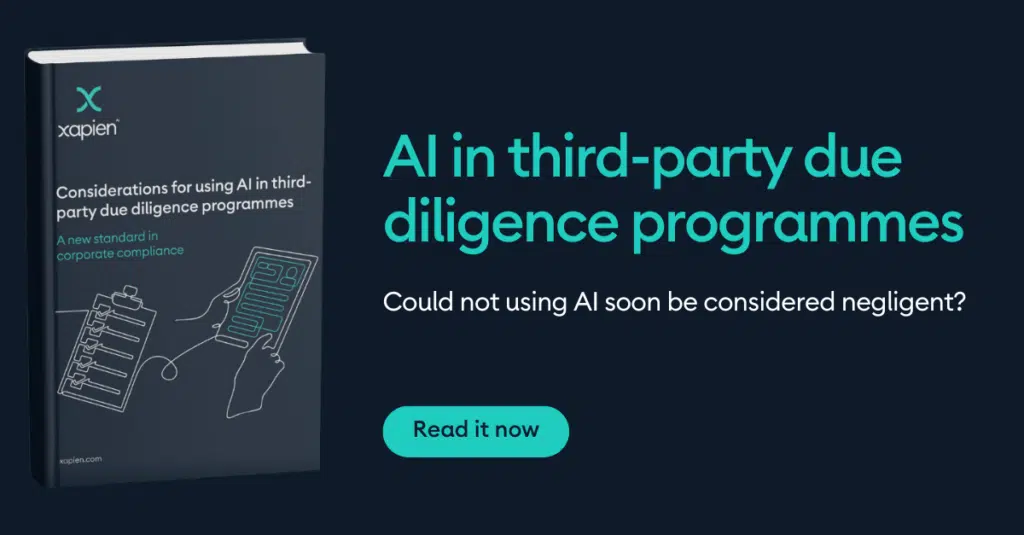
Third party due diligence:
How AI can streamline supply chain due diligence

Consumers, investors, and employees are more socially conscious than ever. They expect transparency and accountability from the companies they support, invest in, and work for. Failing to meet these expectations can quickly lead to a loss of trust and loyalty. With the rise of social media and online platforms, the public has unprecedented access to scrutinise a company’s actions. Particularly around environmental, social, and governance (ESG) standards. Societal pressure, driven by consumer activism and the threat of reputational damage, highlights the importance of supply chain due diligence. And most importantly, truly knowing the third parties you are doing business with.
The need for supply chain due diligence
As supply chains become increasingly global and complex, corporations face growing pressure to ensure they are free from risks. Effective supply chain due diligence is critical to navigating these challenges, but it’s a time-consuming and complex task.
Supply chains have become more interconnected, spanning multiple countries and regions. Tracking all the risks associated with third parties proves challenging for corporations. It’s especially hard when they must conduct due diligence across various languages and jurisdictions. Human error is a significant concern since critical information, such as local news reports, can easily be overlooked.
Additionally, the risk landscape is evolving. In addition to traditional risks like financial crime or regulatory violations, companies now face emerging threats such as human rights abuses, forced labour, and environmental harm. Governments and consumers are increasingly scrutinising these risks, requiring businesses to align their compliance and procurement processes with these new realities
Governments are taking stronger action to address corporate supply chain risks. New regulations are emerging globally to hold companies accountable for the practices of their third parties. Take the Corporate Sustainability Due Diligence directive as an example, which came into effect on 25 July 2024.
Third-party due diligence challenges
One of the biggest challenges in compliance today is the overwhelming amount of data about them. To put this into perspective, Statista reported that the world held 64.2 zettabytes of data in 2020. That’s a figure projected to grow to 181 zettabytes by 2025.
Compliance teams also face pressure on headcounts and budgets, limiting their capacity to handle the growing volume of third-parties. Companies often hesitate to invest in technology unless they have recently faced fines from regulators like the Serious Fraud Office or the Department of Justice. But without sophisticated technology, managing third-party risks becomes increasingly challenging.
Database screening and keyword searches no longer provide the depth required to apply a robust, risk-based approach. Just because a third party doesn’t appear in a database doesn’t mean they are risk-free; it only means they haven’t been flagged by that particular system. As global compliance standards evolve, relying on these limited methods could expose companies to significant supply chain risks that remain hidden.
To overcome these challenges, companies need to adopt technology to get a complete and actionable view of their third parties and the risks they pose. AI has the ability to sift through vast amounts of unstructured data, identify patterns that traditional searches miss, and provide insights that human researchers would struggle to capture.
This shift towards AI-driven compliance is supported by the Department of Justice (DOJ), which released updated guidance for corporate compliance programs that incorporate AI. This new framework, known as the DOJ’s Evaluation of Corporate Compliance Programs, aims to assist federal prosecutors in assessing these systems more effectively.

How AI can augment supply chain due diligence
AI can search and analyse vast amounts of data from open sources and summarise information pertinent to third parties in a ready-to-use report format. Tools such as Xapien empower corporate compliance teams to tap into this information quickly and use it as a starting point for deeper scrutiny—one that’s significantly more advanced than what has existed.
There’s value in using AI in the initial stage of the due diligence process. If you search for a third party on Google, you will get back millions of results. This highlights the challenge of distilling relevant information from the vast public domain. If a human were to read through millions of articles, it would take an unimaginable amount of time—likely many years. In contrast, Xapien generates a due diligence report in just under 10 minutes.
AI distils information within minutes, enabling compliance teams to assess risks right away. For example, AI can cross-reference third parties against sanctions lists and watchlists, determining if any matches exist. But it doesn’t stop at structured data. It can also identify risks related to financial crime, ESG issues, reputational damage, or legal proceedings that are mentioned in media reports or other sources.
This level of insight allows compliance teams to know almost instantly where deeper investigations are needed. If no risks are identified, the third party can be classified as low-risk, and the team can focus on higher-priority cases. This efficiency transforms how corporate compliance teams and due diligence firms operate, allowing them to conduct risk assessments on a much larger scale than ever before.
Streamline supply chain due diligence with Xapien
Xapien can search and analyse information about a third party in your supply chain in minutes. Using a generative AI layer protected by anti-hallucination technology, it summarises its findings into a report that is easily understandable for anyone, from in-house due diligence analysts to external firms initiating investigations. A proprietary disambiguation engine underpins Xapien’s search capabilities, ensuring that final reports are solely about the intended subject to reduce false positives. The report includes clear and concise sections on all identified risks and a chronological timeline of adverse media coverage. This allows researchers to focus on historical events and recent news that curated news databases may miss. A critical feature is the ability to drill down into the report to examine the origins of the information, since knowing the provenance of data and being able to interrogate it is essential in a regulatory context.

Monthly learnings and insights to your inbox
Xapien streamlines due diligence
Xapien's AI-powered research and due diligence tool goes faster than manual research and beyond traditional database checks. Fill in the form to the right to book in a 30 minute live demonstration.